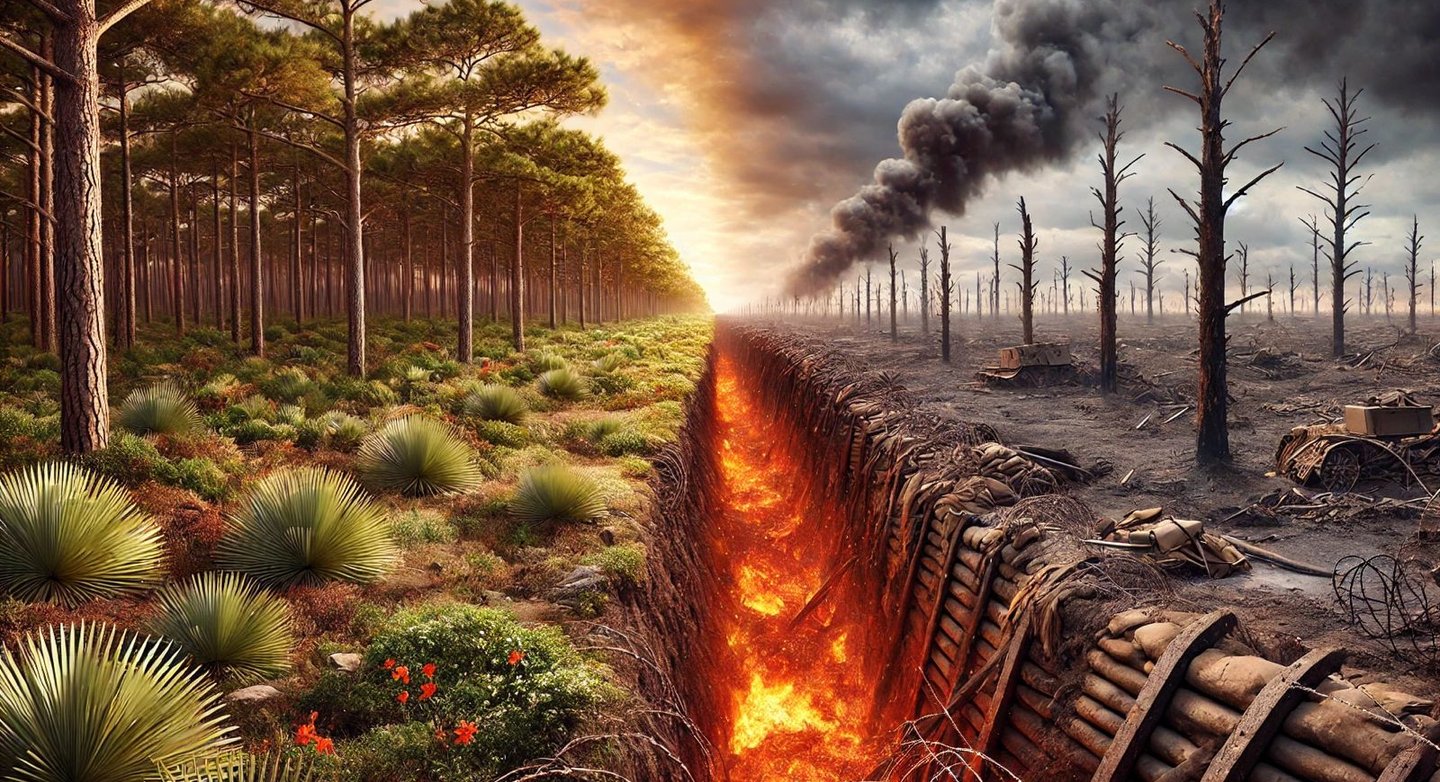Strategizing from 6 cities across the globe
The Pine Rocklands: A Dead Land Walking
Degrading ecosystems is one of the clearest signs of climate change today. There is no better poster child for this anthropogenic phenomenon than the image of a polar bear on a melting polar ice cap. As the story goes, earth is warming and icebergs are melting; the once scenic view has become less desirable to look at, and animals are struggling to survive.
ENVIRONMENTCLIMATE CHANGESUSTAINABILITYNATURE
Laura Attarian
11/1/20247 min read


Degrading ecosystems is one of the clearest signs of climate change today. There is no better poster child for this anthropogenic phenomenon than the image of a polar bear on a melting polar ice cap. As the story goes, earth is warming and icebergs are melting; the once scenic view has become less desirable to look at, and animals are struggling to survive. Unfortunately, this is not a reality only faced by the Arctic and polar bears, this phenomenon is occurring everywhere. Whether it is a direct result of global warming such as the Arctic, or of other human led activity like urbanization in the Amazon rainforest, or because of pollution in the Pacific ocean, climate change is quickly taking over the once uniquely pristine natural environments that earth had to offer.
Humans tend to distance themselves from environmental problems, especially if residing far from the problem. Many Americans feel that the poster of a polar bear sitting on a melted iceberg is just that, a poster. But perhaps the reason why they feel so distant is because many of us currently live in a version of this sort of anthropogenic degradation that has trespassed beyond our realization. Living in a large city makes us feel disconnected from issues like the Pacific, or the Arctic, or the Amazon rainforest. What we don't realize is that the global scale of climate change might have distracted us from catastrophes happening in our own backyard.
Floridians are no stranger to climate change disasters. Just this year, two major hurricanes swept through the Florida coastline causing $34 billion in structural damages killing almost 300 people (2024; Sutton et al. 2024). This is not the first time a storm so catastrophic has impacted this southern community, but it is abnormal to receive two major hurricanes in a month. Sea levels rising, oceanic pollution, abnormal weather patterns, are just some of the consequences of climate change Florida is having to grapple with, but these are not the only. South Florida is home to a unique ecosystem called Pine Rocklands. However, recent estimates determined less than 2% of this ecosystem remains (Matthew & Koptur 2017). The once undamaged ecosystem crossed the South Florida peninsula, but developmental demands in the last century have left this forest on the verge of extinction. When discussing endangered habitats, there is no greater example for Floridians than their own Pine Rocklands. By understanding the threats to the Pine Rocklands, we can also delve into the intricate relationship of urbanization and climate change and realize that there's no "one size fits all" solution when it comes to nature. These are complex environments that require a custom solution, which is why restoring the environment is not a fast nor easy process. This storyline is a lot more common than we tend to realize. One of the greatest obstacles to solving the climate crisis is the undeniable focus of the climate crisis as a whole, instead of the local parts that are at the very root of this global problem.
The Florida Pine Rocklands is an absolutely fascinating ecosystem. This savannah-like environment is unique due to its dry composition while still being situated in the tropics. It's filled with slash pine and a variety of other herbs with an abundance of native flora (Matthew & Koptur 2017). Like the native flora, the Pine Rocklands has an array of endemic fauna that contribute to the salience of this environment. The Miami tiger beetle, a tiny iridescent beetle thought to be extinct in the 1930s was recently rediscovered in 2007, and is now considered to be critically endangered (Matthew & Koptur 2017). The Atala butterfly is another example of the fascinating yet endangered species in this forest (Matthew & Koptur 2017). These are just a couple of the 98 imperiled species that reside in this critical habitat (Marlowe 2024).
Over the years, the Pine Rocklands has faced attacks from every angle: from new housing to a Walmart supermarket construction, urbanization is rampant and land-desperate developers seek to destroy the remnants of this endangered habitat. Plans to build a water park on Zoo Miami's parking lot, a region surrounded by pine rockland forest, was the most recent incident surrounding the endangered ecosystem. Environmentalists fought hard to prevent this development, which would further endanger Florida bonneted bats that use the lot as hunting grounds after sunset. After a three year battle, the court ruled in their favor, and plans for "Miami Wilds", the ironic name of the water park, were terminated (Bennet 2023).
Unfortunately, the battle might not be over just yet. One of the reasons why land developers seek the Pine Rocklands to build infrastructures is because it is elevated two to seven feet above normal ground level. Since South Florida is prone to flash flooding, construction in these sites is favorable (Matthew & Koptur 2017). Additionally, this ecosystem is ingrained within the Miami-Dade county, and whatever is left of the Pine Rocklands only remains in small patches of land scattered around the city. With smaller fragments, fewer species of animals and plants are sustained and less gene diversity remains in these populations, which has a domino effect leading to potential extinction. As Ian Matthew Jones and Suzanne Koptur described, this really is a dead land walking.
Urbanization is not the only threat to the Pine Rocklands, it must also withstand the rise in hurricanes in the Atlantic ocean. While hurricanes are a naturally occurring phenomenon, the rate and strength at which they are hitting land are abnormally high. Take this year's hurricane season, with two major hurricanes hitting the same coast of Florida in less than two weeks. It is no coincidence that hurricanes are increasing at the same rate as climate change, and it has been proven that warmer water temperatures generate more heat energy and the higher the potential for a hurricane to develop (Berardelli 2019). These storms have not only affected Southern communities but the wildlife residing in the Florida state, including the Pine Rockland critters. Gopher Tortoises often create burrows in dunes neighboring the Pine Rocklands that become demolished by strong storms (Hardin 2006). Hurricanes are prominent during the wet summer season which coincides with a clear fluctuation in gopher tortoises populations annually. However, there's an obvious annual population decline concurring with the increasing number of hurricanes each year (Hardin 2006). These extreme patterns are not exclusive to Florida, wildfires, earthquakes, and droughts are on the rise and are affecting humans as well as the endemic ecosystems and the animals that inhabit them across the United States (2020).
The Pine Rocklands are also prone to fires. In fact, it is necessary to prescribe annual burnings to allow new vegetation to grow. In the age of global warming, there is something ironic about a fire being used to promote the health and longevity of this environment. This is, literally, a flicker of hope in the dark. The path to save the Pine Rocklands is the very same thing that has been destroying other ecosystems across the globe. Just this year, massive wildfires in California caused havoc in nature and accelerated deforestation, contributing to climate change. Every ecosystem seems to be meeting the same fate; however, you cannot use the same stone for these two birds. What works as a solution for the revitalization of one ecosystem could be lethal with the other. The beauty of the earth is that we have found a perfect balance between every biome, but with global warming on the horizon, few ecosystems will be able to handle a condition they were not made for.
While I recognize that there are infrastructures provided by the absence of the Pine Rocklands that have helped human development, contributed to the local economy, and granted housing for a populous city, nature matters. Being such a small ecosystem, the Pine Rocklands and its species might seem insignificant when discussing climate change at a larger scale. But the culmination of these small ecosystems across America represent a larger environmental loss, and suddenly these small habitats matter. Climate change and urbanization are often discussed in separate conversations. But, global warming began at the start of the Anthropocene, which marks the start of urbanization as well. The Pine Rocklands crisis is just a fraction of what is happening globally, but this ecosystem accurately captures the catastrophe happening in the natural world today. Animals and plants are edging extinction and nature is being completely replaced by urban development all around the world. Society needs to take a step back to acknowledge the local scale environmental issues and protect habitats that exist in proximity to them. If we only focus on larger issues at hand such as global warming, we never reach the root of the problem which could simply be the urban development that threatens a habitat such as the Pine Rocklands. We cannot save the earth without saving our garden first.
References
Jones, Ian Matthew, and Suzanne Koptur. “Dead Land Walking: The Value of Continued Conservation Efforts in South Florida’s Imperiled Pine Rocklands.” Biodiversity and Conservation, 2017, p. 1. EBSCOhost, doi:10.1007/s10531-017-1433-6.
Waddle, J. Hardin, et al. “Changes in Abundance of Gopher Tortoise Burrows at Cape Sable, Florida.” Southeastern Naturalist, vol. 5, no. 2, 2006, pp. 277–284. JSTOR, www.jstor.org/stable/3878207.
Norman, Gene, and Allison Chinchar. “The 2020 Hurricane Season Could Set a Record for Most Named Storms.” CNN, Cable News Network, 3 Oct. 2020, www.cnn.com/2020/10/03/weather/gamma-rapid-intensification-on-record-season/index.html.
“How Climate Change Is Making Hurricanes More Dangerous " Yale Climate Connections.” Yale Climate Connections, 21 July 2020, yaleclimateconnections.org/2019/07/how-climate-change-is-making-hurricanes-more-dangerous/.
“5 Natural Disasters That Beg for Climate Action.” Oxfam International, 7 Apr. 2020, www.oxfam.org/en/5-natural-disasters-beg-climate-action.
“Natural Resources Conservation Service.” NRCS, www.nrcs.usda.gov/wps/portal/nrcs/detail/national/plantsanimals/fishwildlife/?cid=stelprdb1047006.
Elise Bennett. “Legal Victory Restores Safeguards for Miami-Dade Wildlife Habitat Threatened by Controversial Water Park.” Center for Biological Diversity, 11 Dec. 2023, biologicaldiversity.org/w/news/press-releases/legal-victory-restores-safeguards-for-miami-dade-wildlife-habitat-threatened-by-controversial-water-park-2023-12-11/.
Starling, Marlowe. “Pining for the Rocklands.” The Marjorie, 14 May 2024, themarjorie.org/2024/05/14/pining-for-the-rocklands/.
“Helene, Milton Losses Expected to Surpass “Truly Historic” $50 Billion Each.” Cbsnews.com, CBS News, 17 Oct. 2024, www.cbsnews.com/news/helene-milton-losses-50-billion-each-hurricanes-rare/.
Sutton, Joe, et al. “Helene Death Toll Rises to at Least 227 across 6 States.” CNN, 5 Oct. 2024, www.cnn.com/2024/10/05/us/helene-death-toll-rises-saturday/index.html.
